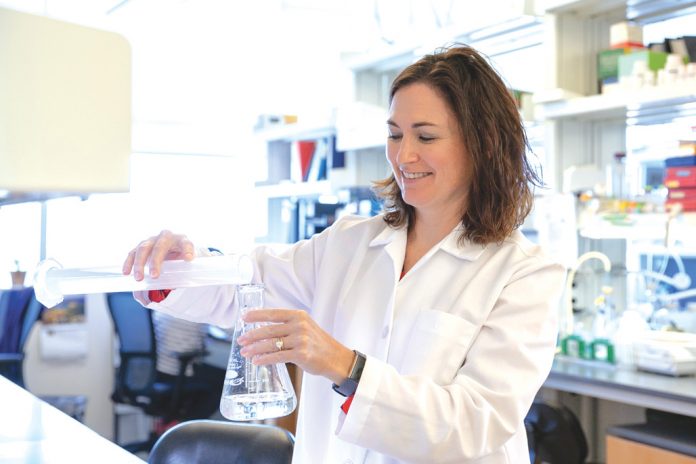Scientists at the Oklahoma Medical Research Foundation have stumbled onto a finding that could alter future treatment options for conditions ranging from heart attacks to life-threatening infections.
The discovery involves the inner workings of the omentum, a mass of tissue that connects the stomach to other abdominal organs and is critical in the body’s immune response.
The omentum can act as a powerful Band-Aid. Following a mastectomy, surgeons often place strips of it over a reconstructed breast to regrow lymphatic vessels, which are crucial in fighting infection. But the omentum’s healing properties aren’t well understood, and it wasn’t the original focus of research led by OMRF scientist Courtney Griffin, Ph.D. (story continues below)
“We were studying the role of a certain molecule in lymphatic vessels, but the approach we took led us toward the omentum,” Griffin said. “The time it added to our research was well worth it because it resulted in a far better understanding of this fascinating tissue.”
The study involving mouse embryos showed that when red blood cells naturally leak from the omentum before birth, a white blood cell called a macrophage is triggered to produce an inflammatory protein, or cytokine. This specific cytokine, called IL-1 beta, causes the omentum blood vessels to continue leaking during development.
“We also learned that IL-1 can make lymphatics more functional in the embryonic omentum,” Griffin said. “Normally, new lymphatics are so busy growing that they aren’t focused on their eventual job of collecting fluid and transporting cells from tissues. IL-1 makes them act more like mature lymphatics.”
Understanding how and why that process occurs is critical, she said, because current treatments for heart attacks, sepsis and other conditions often include a drug that blocks IL-1 and other cytokines.
Cytokines are “a double-edged sword,” Griffin said, because they help fight infections, but when released en masse, they attack healthy tissue, often causing organ damage. The term “cytokine storm” has become common over the past two years to describe cytokines’ harmful impact in people with severe Covid-19.
“Our research shows the flip side of IL-1, which has previously been seen as harmful in large quantities,” she said. “A wound or an infection stimulates growth of new lymphatics, and it appears that IL-1 might help them function more quickly to heal tissues. If this finding is confirmed through additional research, it could help physicians decide that a slight delay is beneficial when prescribing a cytokine blocker.”
The findings were published in the journal Circulation Research. Griffin said subsequent studies are needed to verify that the same process occurs in mature mice and, eventually, in humans.
The research was funded by National Institutes of Health grant Nos. R35HL144605, R01HL134788, P30GM114731 and P20GM139763, and American Heart Association grant No. 16POST31300013.












